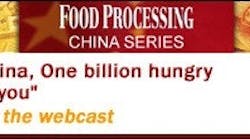China is a rapidly changing, rapidly maturing market. Perhaps no other country has moved so quickly from an agrarian society to a manufacturing one, from communism to its own brand of capitalism, and from an export economy to a consuming one.
They may not be completely there on that last point, but the Chinese are moving in that direction. That means now is the time for opportunistic food companies to consider setting up shop in China in some way. It’s a scary proposition, but help is available. For starters, let Food Processing give you a primer in the form of an on-demand webcast: “Four steps to China: A billion hungry customers await you.”
Our four steps are foundational strategies (including a business plan); formation and post-formation activities (including site selection and paperwork); operational set-up (including staffing, training and finding partners); and capital strategy, taxes and asset protection.
Three experts on business in Asia will help you navigate the China Sea:
- Jim Rice,
- Tyson Foods Vice-President and General Manager of its China operations, has been guiding the animal protein company's successful operations in China since 2004. Before that, he had 14 years of experience setting up American businesses in China.
- Alex Bryant
- is President of EastWest Associates, a sourcing and consulting firm for U.S. manufacturing companies accessing the global market, particularly in southeast Asia and China.
- Jeff Olin
- is a managing partner – international tax services U.S. for accounting firm Grant Thornton LLP, specializing in preparing businesses for the world in terms of global tax planning and analysis. He has degrees in both accounting and law.
For 45 minutes, they share Bryant’s advice on how to navigate the bureaucracy and the paperwork, Olin’s strategies for cash flow and asset protection and Rice’s anecdotes about Chinese workers and how to gain acceptance for an American food company. The result is a compact but effective and free introduction to a market you must consider.
Keep in mind:
- China has more than four times the population of the U.S. but only one-third of the farmable land -- that implies a huge potential for agricultural-based food products.
- The market for imports is strong and growing rapidly, and the Chinese have a particular fondness for American products.
- With less time on their hands but more money, the Chinese will seek out value-added food products. They already are, and it's that wave, and hopefully the crest of it, that we're trying to help you latch onto with this webcast.
The presentation includes 26 Powerpoint slides, 45 minutes of discussion including a question-and-answer session and a full transcript. “Four steps to China” is archived on this website. You may view and listen to it at your convenience, even setting it aside for indefinite amounts of time until you return to either continue from where you left off or to hear it from the start. Print out the Powerpoints. Share the URL with colleagues. Use it as the start of your China business plan.
It’s free. See the large horizontal bar halfway down our home page (image below) or click on the “Webcast” tab at the top of every page.


